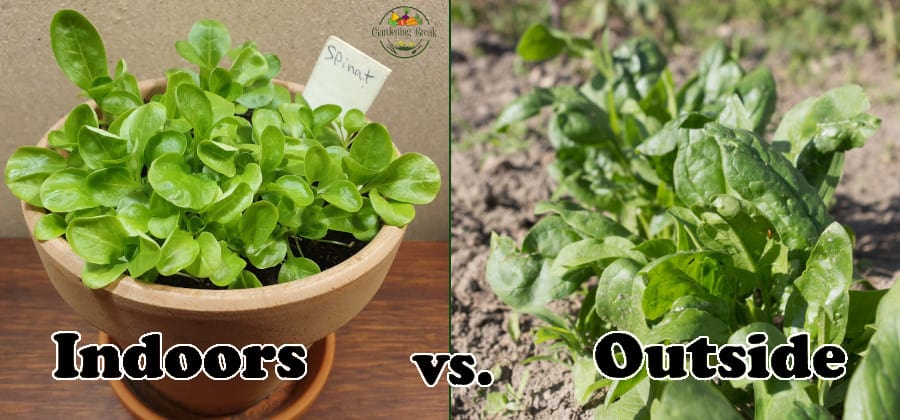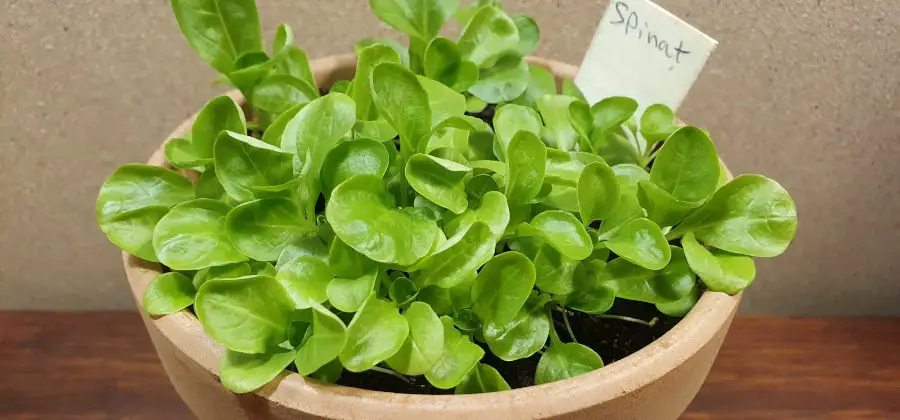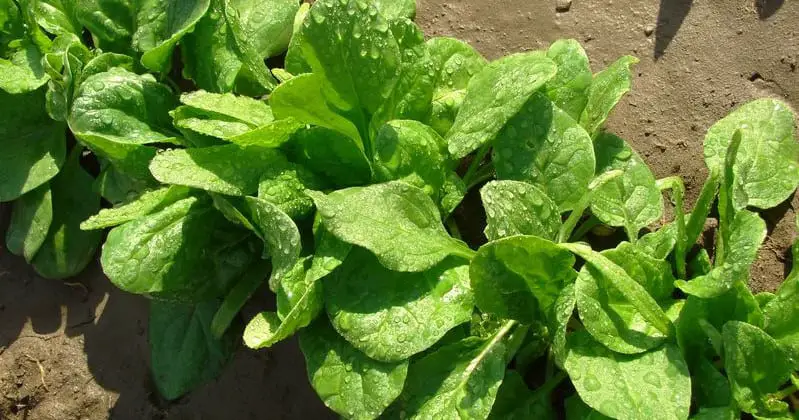This post contains affiliate links.

You may have heard that spinach can be grown both indoors and outside. That is absolutely true, but there are some differences between the two methods that might make one better for you. I have written this article to help you figure out if you should grow your spinach indoors or outside. Here is the key takeaway:
Spinach typically grows better outside than indoors, although it can also grow very well indoors. The primary reason why spinach typically grows better outside than indoors is that there is more sunlight, so if spinach can get enough sunlight indoors, it can also grow very well there.
Even though it can be easier to grow spinach outside, it can also be done indoors and, in some cases, just as good as outside. While both indoors and outside can work very well, there are advantages and disadvantages to each, which I will explain in this article, so keep reading.
Growing Spinach Indoors vs. Outside: Which Is Better?
Spinach is one of my favorite plants to grow indoors since it can grow really well next to a window or somewhere else where it can get some sunlight. That said, it can usually grow even better outside, so what should you do? Should you grow your spinach indoors or outside?
As a general rule, spinach grows better the more sunlight it gets, which means that growing it outside is usually better than inside. That said, getting more than 14 hours of sunlight per day will make the spinach bolt, which causes it to produce seeds instead of growing and producing leaves.
If you want to know more about how to tell if your spinach is about to bolt, why it happens, and what to do, I recommend reading this article.
The primary advantage of growing spinach outside is that there is more sunlight as well as sunlight from more angles, but if you have a spot inside where it can get some sunlight, such as a south-facing window, you can definitely grow spinach there. I grow spinach indoors from early spring to late fall every year, so it definitely works.
In my opinion, the most important thing to consider when deciding if you should grow spinach indoors or outside is where you prefer to have it growing. As long as it can get at least 4 hours of sunlight per day, it should be fine, although more sunlight is generally a good thing and will make your plant more productive (up until around 14 hours). You can read more about how much sunlight spinach should get on this link.
In conclusion:
You can grow spinach both indoors and outside as long as it can get 4-14 hours of sunlight per day, but it is usually a bit easier and more productive outside because there is more sunlight.
It might sound like growing spinach outside is the clear winner based on what I have written so far, but there are also quite a few advantages of growing your spinach indoors.
Below, I cover the advantages and disadvantages of growing spinach indoors compared to outside, and after that, I cover some more advantages and a few disadvantages of growing it outside.
Advantages of Growing Spinach Indoors Compared to Outside

There are several advantages to growing spinach indoors compared to outside. Here are the advantages:
It is easy to control how much water it gets
Since it doesn’t rain inside your house or apartment (I would assume), you have full control of how much water your spinach gets. That means you don’t have to worry about it drowning or becoming overwatered because of rain.
You have full control of what is in the soil
Spinach grows best in nutrient-rich and well-drained soil. When you grow spinach indoors, chances are you will be using a pot, so you have full control of what you put in it. The soil in your garden might be perfectly fine too, but when you use a pot, you will be sure of what goes in it.
There are no birds or large critters to worry about
Something you don’t have to worry about when growing spinach indoors is birds, deer, rabbits, hares, or other four-legged critters. There are a couple of simple ways to keep birds and critters away, such as bird netting or flash tape, but you don’t have to think about that if you grow your spinach indoors.
There are (almost) no insects to worry about
Like for larger animals, it is a lot harder for insects and bugs to get to your spinach if it is indoors. It is not impossible, though, and in my experience, it is pretty common that some insects can find their way to your spinach, even if you keep it indoors. Especially if it is near an open window. You can use neem oil to keep insects off your spinach pretty effectively, though.
You can start spinach earlier indoors than outside
If you have a spot indoors that gets a lot of sunlight, such as a south-facing window, you can most likely grow spinach there from earlier in the spring than you can grow it outside. This is simply because it is warmer, and even though spinach can survive temperatures as low as 20°F (about -7°C), it grows faster and better at warmer temperatures. Just make sure it can get at least 4 hours of sunlight per day.
You can grow spinach indoors all year with grow lights
A huge advantage of growing your spinach indoors is that you can do it literally all year round. For the months without much sunlight, you just need some grow lights or another system to provide enough light. I use a so-called smart garden to grow some plants in the winter when there is not much sunlight, although I have not tested spinach in it yet.
Disadvantages of Growing Spinach Indoors Compared to Outside
As you can see above, there are a lot of advantages of growing your spinach indoors, but there are also some quite significant disadvantages you should know about.
The primary disadvantage of growing spinach indoors compared to outside is that there usually isn’t as much sunlight indoors, which makes the plants grow slower and be less productive.
If you live somewhere with a very high amount of direct sunlight, it could actually be better to grow spinach indoors since too much sunlight will cause the spinach to bolt faster, which changes its focus from growing and producing leaves to producing seeds.
Another disadvantage of growing your spinach indoors is that it won’t have as much room for the roots if you grow it in a pot as if you grew it directly in the ground. Less room for roots means smaller, slower-growing plants, but if you just get a large enough pot, you will have solved that problem.
Pots like these (link to Amazon) are plenty large for a single spinach plant. I even like to plant a few in each pot of that size, although each plant won’t be as large as if you only plant one per pot.
The last disadvantage of growing your spinach indoors I could think of is that you have to water it all the time. Of course, not literally all the time, but there won’t be any rain to help you out, which means you have to make sure it gets enough water. I like to see this as an advantage, though, since you are in full control of the watering.
Advantages of Growing Spinach Outside Compared to Indoors

As I have already explained in this article, spinach generally grows faster and gets bigger outside than indoors since there is usually more sunlight. That is not the only advantage, however, so keep reading to learn more.
Here are the advantages of growing spinach outside compared to indoors:
There is usually much more sunlight outside than indoors
I have already covered it a lot in this article, but let me just say it one more time, sunlight is the key to productive spinach. Since there is usually more sunlight and it comes from more angles outside, your spinach will grow faster and be more productive than indoors.
Rain can take care of some of the watering
One of the key differences between growing plants indoors and outside is that it rains outside. This might seem obvious, but it can actually make a very big difference in how much you need to water your spinach. Depending on how much it rains where you live, you might not have to water your spinach much at all if it is growing outside. The only thing is that rain is usually not very reliable and can also come in such extreme amounts that it will damage your spinach.
More room for the roots to grow means bigger plants
If you grow your spinach in the ground, its roots generally have more room than if you grow it in pots. This is a pretty big advantage since more room for roots generally means bigger and faster-growing plants. The only thing is that you can make up for the lack of room by getting some bigger pots. 6-inch pots will be perfect for one spinach plant and can even have more in them, although they won’t get as big as if you only have one plant in each.
Spinach can reseed itself and grow back for more free spinach
The last advantage of growing spinach outside compared to indoors I could think of is that spinach can actually reseed itself under the right conditions. If the plant bolts and successfully goes to seed, the seeds can be spread naturally in a number of ways, which can get you a bunch of free, extra spinach. You can read much more about that on this link.
Disadvantages of Growing Spinach Outside Compared to Indoors
As you can see, the primary advantage of growing spinach outside is that more room and sunlight usually leads to bigger, faster-growing, and more productive plants. There are also disadvantages of growing spinach outside, though. Here is what you should know.
The biggest disadvantage and risk of growing spinach outside is that birds or other animals might eat it. This can be solved by using bird netting, flash tape, or other methods. Another risk is that too much rainwater can damage the plants.
You can protect your spinach from birds and other animals very efficiently by using bird netting or flash tape. Scarecrows can also work sometimes. I have another article about how you can protect your spinach where I talk more about these and a few more methods for protecting spinach outside.
Should You Start Spinach Indoors? Explained
I have talked a lot about whether you should grow spinach indoors or outside in this article, but there is also the option of starting your spinach indoors and then moving it outside later.
It is a good idea with many plants to start them indoors and then put them outside later, but for spinach, I honestly haven’t ever felt much of a difference. I always just sow my spinach seeds directly where I want the plants to grow, and it almost always works. That way, I don’t have to think about transplanting them and such.
One situation where it makes a lot of sense to start spinach indoors is if you want a headstart before it gets warm or sunny enough outside.
You can start spinach indoors about a month before the last expected frost and then put it outside when that month is over. You don’t have to worry too much about hitting the perfect day to put it outside because spinach can survive down to 20°F (about 7°C).
As they write in this article from Oregon State University Extension, “Cold weather doesn’t kill these hardy plants; it simply slows their growth rate”. It is a very interesting read if you want to learn more about plants that can survive frost, including spinach.
If you decide to start your spinach indoors, the most important thing is to make sure it gets enough light. Either sunlight or, if there isn’t enough of that, grow lights.
